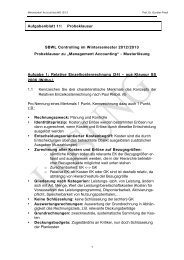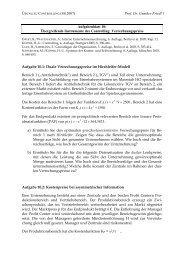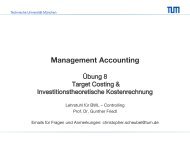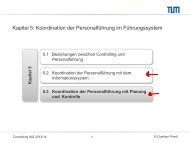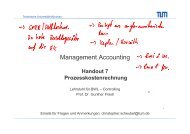Lecture 9 - Lehrstuhl für Controlling - Technische Universität München
Lecture 9 - Lehrstuhl für Controlling - Technische Universität München
Lecture 9 - Lehrstuhl für Controlling - Technische Universität München
You also want an ePaper? Increase the reach of your titles
YUMPU automatically turns print PDFs into web optimized ePapers that Google loves.
<strong>Technische</strong> <strong>Universität</strong> <strong>München</strong><br />
A balanced scorecard combines financial as well as non-financial<br />
value drivers<br />
<br />
Apart from the financial perspective (with the EVA as the top level performance<br />
measure, for instance) other, non-financial perspectives are explicitly taken into<br />
account as a means of supporting shareholder value creation<br />
Financial Perspective<br />
To succeed financially,<br />
how should we appear to our shareholders?<br />
objectives measures targets initiatives<br />
Customer Perspective<br />
To achieve our vision,<br />
how should we appear to our customers?<br />
objectives measures targets initiatives<br />
Vision and<br />
Strategy<br />
Internal Business Process<br />
To satisfy our shareholders and customers,<br />
what business processes must we excell at?<br />
objectives measures targets initiatives<br />
Learning and Growth<br />
To achieve our vision, how will<br />
we sustain our ability to cange and improve?<br />
objectives measures targets initiatives<br />
Value-Based Management: <strong>Lecture</strong> 9<br />
14<br />
Figure adapted from Kaplan / Norton (1996)<br />
© Gunther Friedl – SS 2013




